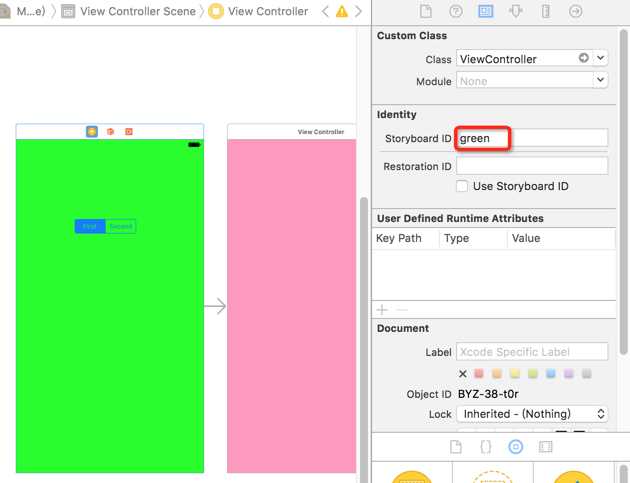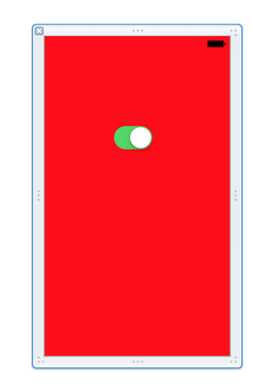标签:term art ima opengl round ports cti case view
// // AppDelegate.m // 05-控制器的创建(storyboard) #import "AppDelegate.h" @interface AppDelegate () @end @implementation AppDelegate - (BOOL)application:(UIApplication *)application didFinishLaunchingWithOptions:(NSDictionary *)launchOptions { // Override point for customization after application launch. // 创建窗口 self.window = [[UIWindow alloc] initWithFrame:[UIScreen mainScreen].bounds]; // 创建窗口的跟控制器 // 加载storyboard // storyboard文件名,不需要带后缀 // nil: [NSBundle mainBundle] UIStoryboard *storyboard = [UIStoryboard storyboardWithName:@"Main" bundle:nil]; // 通过storyboard创建控制器 // instantiateInitialViewController:加载箭头指向的控制器 // UIViewController *vc = [storyboard instantiateInitialViewController]; UIViewController *vc = [storyboard instantiateViewControllerWithIdentifier:@"green"]; //加载绿色的view NSLog(@"%@",[vc class]);
self.window.rootViewController = vc; //设置跟控制器;
// 显示窗口 [self.window makeKeyAndVisible]; return YES; } /* 通过storyboard创建控制器的步骤: 1、加载storyboard 2。实例化控制器 */ - (void)applicationWillResignActive:(UIApplication *)application { // Sent when the application is about to move from active to inactive state. This can occur for certain types of temporary interruptions (such as an incoming phone call or SMS message) or when the user quits the application and it begins the transition to the background state. // Use this method to pause ongoing tasks, disable timers, and throttle down OpenGL ES frame rates. Games should use this method to pause the game. } - (void)applicationDidEnterBackground:(UIApplication *)application { // Use this method to release shared resources, save user data, invalidate timers, and store enough application state information to restore your application to its current state in case it is terminated later. // If your application supports background execution, this method is called instead of applicationWillTerminate: when the user quits. } - (void)applicationWillEnterForeground:(UIApplication *)application { // Called as part of the transition from the background to the inactive state; here you can undo many of the changes made on entering the background. } - (void)applicationDidBecomeActive:(UIApplication *)application { // Restart any tasks that were paused (or not yet started) while the application was inactive. If the application was previously in the background, optionally refresh the user interface. } - (void)applicationWillTerminate:(UIApplication *)application { // Called when the application is about to terminate. Save data if appropriate. See also applicationDidEnterBackground:. } @end

06-控制器的创建(xib)

// // AppDelegate.m // 06-控制器的创建(xib) #import "AppDelegate.h" #import "ViewController.h" @interface AppDelegate () @end @implementation AppDelegate - (BOOL)application:(UIApplication *)application didFinishLaunchingWithOptions:(NSDictionary *)launchOptions { // Override point for customization after application launch. // 创建窗口 self.window = [[UIWindow alloc] initWithFrame:[UIScreen mainScreen].bounds]; // 通过xib创建控制器 ViewController *vc = [[ViewController alloc] initWithNibName:@"ViewController" bundle:nil]; self.window.rootViewController = vc; [self.window makeKeyAndVisible]; return YES; } - (void)applicationWillResignActive:(UIApplication *)application { // Sent when the application is about to move from active to inactive state. This can occur for certain types of temporary interruptions (such as an incoming phone call or SMS message) or when the user quits the application and it begins the transition to the background state. // Use this method to pause ongoing tasks, disable timers, and throttle down OpenGL ES frame rates. Games should use this method to pause the game. } - (void)applicationDidEnterBackground:(UIApplication *)application { // Use this method to release shared resources, save user data, invalidate timers, and store enough application state information to restore your application to its current state in case it is terminated later. // If your application supports background execution, this method is called instead of applicationWillTerminate: when the user quits. } - (void)applicationWillEnterForeground:(UIApplication *)application { // Called as part of the transition from the background to the inactive state; here you can undo many of the changes made on entering the background. } - (void)applicationDidBecomeActive:(UIApplication *)application { // Restart any tasks that were paused (or not yet started) while the application was inactive. If the application was previously in the background, optionally refresh the user interface. } - (void)applicationWillTerminate:(UIApplication *)application { // Called when the application is about to terminate. Save data if appropriate. See also applicationDidEnterBackground:. } @end
// // ViewController.m // 06-控制器的创建(xib) #import "ViewController.h" @interface ViewController () @end @implementation ViewController /* 通过xib创建控制器的view 1.一定要描述xib的文件拥有者是控制器,也就是说这个xib是用来描述控制器 */ - (void)viewDidLoad { [super viewDidLoad]; // Do any additional setup after loading the view, typically from a nib. } - (void)didReceiveMemoryWarning { [super didReceiveMemoryWarning]; // Dispose of any resources that can be recreated. } @end

标签:term art ima opengl round ports cti case view
原文地址:http://www.cnblogs.com/laugh/p/6549473.html